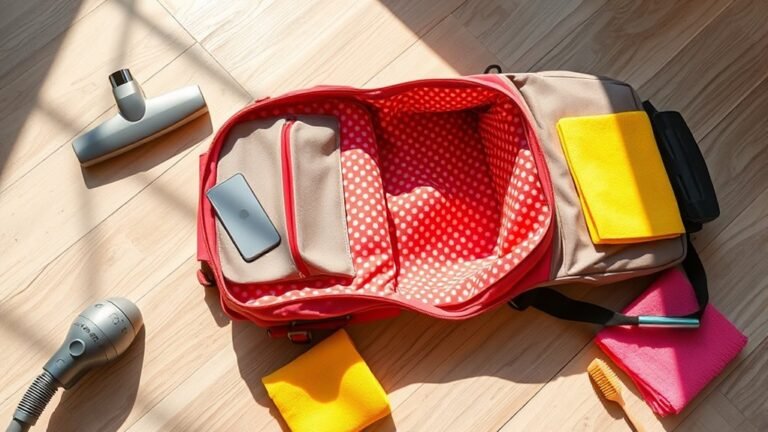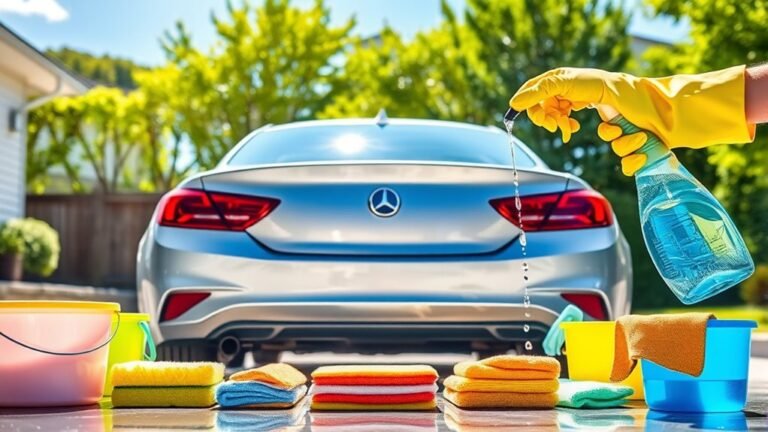Spring Cleaning Guide for Bike
To spring clean your bike, start by preparing it in a well-lit space and gathering cleaning supplies. Clean the frame gently with soapy water, then degrease and lubricate the drivetrain to keep it smooth. Check tires for pressure and tread, and inspect brakes for wear. Adjust gears and cables to guarantee they shift flawlessly. Finish by maintaining accessories and storing your bike properly to protect its longevity. Keep going to uncover detailed tips for each step.
Preparing Your Bike for Cleaning

How do you get your bike ready for a thorough cleaning? Start by finding a spacious, well-lit area where you can work comfortably—freedom begins with a clear workspace. Next, gather essential cleaning supplies: a bucket, bike-specific soap, brushes, rags, and degreasers. Before you jump in, use some bike maintenance tips to inspect your ride—check for loose bolts, brake function, and tire pressure. Removing accessories like water bottles or lights makes the process smoother and protects them from damage. Elevate your bike on a stand or lean it securely to avoid falls. Preparing your bike thoughtfully sets the stage for a deep clean, ensuring every ride afterward feels fresh and unrestricted. With these steps, you’re geared up to reclaim your bike’s performance and your freedom on the road.
Cleaning the Frame and Components
Once your bike is prepped and accessories are removed, it’s time to focus on cleaning the frame and components. This step is essential for frame protection and overall component care, ensuring your ride stays smooth and reliable for your next adventure.
- Use a soft brush or sponge with mild soap and water to gently remove dirt from the frame, avoiding harsh scrubbing that can damage the paint or protective coatings.
- Carefully clean components like brakes, derailleurs, and shifters, removing grime without forcing water into sensitive parts.
- Dry everything thoroughly with a clean cloth to prevent rust and maintain your bike’s pristine condition.
Taking these steps protects your freedom to ride with confidence, knowing your bike is well cared for and ready to hit the road or trail.
Degreasing and Lubricating the Drivetrain

Although cleaning the frame is essential, your bike’s drivetrain deserves just as much attention to keep it running smoothly. Proper drivetrain maintenance guarantees your rides stay effortless and free, without the drag of dirt and grime. Start by applying a quality degreaser to the chain, cassette, and chainrings, then scrub away the buildup with a stiff brush. Rinse and dry thoroughly to prevent rust. Next, use precise lubrication techniques—apply a bike-specific lubricant sparingly to each chain link while slowly pedaling backward. Wipe off any excess to avoid attracting more dirt. Regular degreasing and lubrication keep your drivetrain efficient and extend its life, letting you embrace the open road with confidence and ease. This simple step fuels your freedom to roam without mechanical worries.
Inspecting and Maintaining Tires and Brakes
Now’s the perfect time to check your tire pressure and tread to guarantee a smooth ride. You’ll also want to inspect your brake pads for wear and make certain the cables are tight and responsive. Keeping these parts in good shape is key to your safety and performance on the road.
Tire Pressure and Tread
Before you hit the road, checking your tire pressure and tread is essential to ascertain a safe and smooth ride. Proper tire maintenance guarantees you enjoy the freedom of the open road without unexpected flats or slips. Here’s what you need to focus on:
- Air Pressure: Use a reliable pump or gauge to inflate your tires to the recommended PSI, found on the tire sidewall. Correct air pressure improves control and efficiency.
- Tread Depth: Inspect your tires for worn-down tread or bald spots. Good tread grips the road, especially in wet conditions.
- Damage Check: Look for cracks, cuts, or embedded debris that could lead to punctures.
Brake Pads and Cables
Two key components you should regularly check for safe riding are your brake pads and cables. Worn brake pads mean less stopping power, so timely brake pad replacement is essential. Also, cables can stretch or fray over time, making cable adjustment necessary to keep brakes responsive and smooth.
| Component | What to Check | Action Needed |
|---|---|---|
| Brake Pads | Thickness & wear | Replace if thin |
| Brake Cables | Tension & fraying | Adjust or replace |
| Brake Levers | Smooth operation | Lubricate or tighten |
| Brake Arms | Alignment | Realign if uneven |
Taking care of these parts guarantees you ride freely with confidence on every path.
Checking and Adjusting Gears and Cables

Smooth shifting depends on properly checked and adjusted gears and cables. To keep your ride feeling free and effortless, focus on gear alignment and cable tension. Here’s how to make certain your drivetrain works flawlessly:
- Inspect the gear alignment by shifting through all the gears; if the chain hesitates or skips, adjust the derailleur position.
- Check cable tension by squeezing the shifter; cables should be taut but not overly tight, allowing smooth gear changes.
- Lubricate the cables lightly to prevent rust and guarantee they glide freely inside the housing.
Final Touches and Storage Tips
After verifying your gears and cables are in top shape, it’s time to focus on the final touches that will keep your bike ready to roll. Start by cleaning and lubricating the chain to prevent rust and guarantee smooth rides. Check your bike accessories like lights, bell, and reflectors—replace batteries or fix any loose parts. Next, consider smart storage solutions to protect your bike when it’s not in use. A wall-mounted rack or a sturdy bike stand can save space and keep your bike off damp floors, preserving its frame and components. Proper storage not only extends your bike’s life but also keeps it instantly accessible, so you’re always ready to embrace the open road whenever freedom calls.
Frequently Asked Questions
How Often Should I Replace My Bike Chain?
You don’t want your chain to quietly retire when you’re miles away from freedom. Keep an eye on chain wear because it’s the subtle whisper telling you when it’s time for replacement. Indicators like slipping gears or a stretched feeling mean you shouldn’t wait. Generally, swapping your chain every 2,000 to 3,000 miles keeps your ride smooth and your adventures endless. Stay ahead, and your bike will thank you with every freewheeling moment.
What’S the Best Way to Store a Bike Long-Term?
When storing your bike long-term, you want to keep it safe and ready for your next adventure. Find a dry, cool spot to avoid rust and damage. Using bike covers is a smart move—they protect against dust and moisture while letting your bike breathe. Elevate your bike or hang it to prevent tire flat spots. Regularly check and lubricate the chain during storage so your freedom to ride stays smooth and hassle-free.
Can I Use Household Cleaners on My Bike?
They say, “Don’t put all your eggs in one basket,” and that applies here—you shouldn’t use just any household cleaner on your bike. Different household cleaner types can harm your bike’s paint, metal, or rubber parts if they’re not compatible. Stick to gentle, bike-specific cleaners or mild soap and water to keep your ride looking great without risking damage. That way, you maintain your freedom to explore without worry.
How Do I Prevent Rust on My Bike?
To prevent rust on your bike, you’ll want to focus on regular rust prevention as part of your bike maintenance routine. Keep your bike clean and dry—moisture invites rust. After rides, especially in wet conditions, wipe down metal parts and apply a light coat of bike-specific lubricant or anti-rust spray. Store your bike indoors or under cover to protect it from the elements. This way, you’ll keep your ride ready for your next adventure.
Is Professional Bike Maintenance Necessary After Cleaning?
You don’t always need professional maintenance after cleaning, but it’s a smart move if you want to boost your bike longevity. While you can handle basic cleaning and checks yourself, pros catch hidden issues that could limit your freedom on the road. Getting your bike professionally maintained guarantees everything’s tuned perfectly, so you ride smoothly and safely, letting you focus on the open road without worries about breakdowns or wear.






